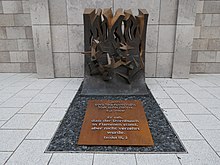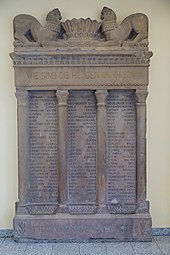Hospitalstrasse synagogue and community center
| Hospitalstrasse synagogue and community center | ||
|---|---|---|
 Hospitalstrasse synagogue and community center with a newly designed front area in 2019 |
||
| Data | ||
| place | Stuttgart | |
| architect | Ernst Guggenheimer | |
| Construction year | 1951-1952 | |
| Coordinates | 48 ° 46 '36.8 " N , 9 ° 10' 18.8" E | |
|
|
||
| particularities | ||
| Synagogue and community center on the foundations of the old synagogue | ||
Hospitalstrasse Synagogue and Community Center is a building erected in 1951/52 by the Israelite Religious Community of Württemberg K.d.ö.R. in Stuttgart .
history
The building is located in Stuttgart-Mitte in the hospital quarter and there at Hospitalstrasse 36. It was built on the foundation walls of the old synagogue , which was destroyed in the November pogrom of 1938 . On May 13, 1952, the synagogue , which was completed according to a design by Ernst Guggenheimer , was inaugurated. The Eternal Light was kindled by the then regional rabbi of Luxembourg, Chaim Lehrmann . The ordinance speech was given by the then regional rabbi Siegbert Izchak .
Building description
synagogue
The construction is in three parts. A larger, cubic hall is flanked by two wings on the entrance side. A three-sided women's gallery runs around the rectangular prayer room . The rectangular windows are designed by Dr. Ulrich Knufinke colorfully glazed. On the east side of the prayer room there is a high niche with the Torah shrine. The new synagogue is designed in the sober architectural style of the Weimar Republic. It avoids any reference to the Old Synagogue built in the style of historicism .
Works of art
To the left of the entrance door to the synagogue is a bronze sculpture Burning Bush by the Stuttgart artist Roda Reilinger.
Other premises
In addition to the large prayer room, there is a small prayer room, the administration wing, a mikveh , a kindergarten , a community hall and a restaurant.
Roll of honor
In the anteroom of the prayer room of the synagogue there is a plaque of honor for the Jewish soldiers from Stuttgart who died in the First World War. The 250 cm high monument was made in sandstone in 1922 by the Stuttgart sculptor Josef Zeitler, based on a design by the Stuttgart architect Wilhelm Ritter von Graf . It is reminiscent of the front view of a temple and consists of a plinth, four round pillars with ornamented bases and capitals, three inscription plates flanked by the pillars and an entablature. The table is crowned by the crown of David , originally decorated with a Star of David , which is flanked by two lions.
The entablature frieze bears the inscription: "How did the heroes fall". The saying is taken from David's lamentation over the deaths of Saul and Jonathan ( 2 Samuel , chapter 1, verse 19). The inscription on the base gives the answer: "1914 For the Fatherland 1918". The three inscription plates bear the names of the 92 Jewish soldiers who died in the First World War, alphabetically according to the family name.
On the night of the pogrom on November 10, 1938, the Old Synagogue was set on fire. All that remained of the synagogue were the mandatory signs from the roof of the building and the memorial for the fallen, which were put up again in the synagogue built in 1952.
literature
- Ulrike Plate: In memory of the First World War. Two memorials in Stuttgart for fallen Jewish soldiers. In: monuments in Baden-Wuerttemberg Volume 43, 2014, online: .
Web links
- Central Council of Jews in Germany - Synagogue and Community Center Hospitalstrasse
- Description at Alemannia Judaica
Footnotes
- ↑ #Plate 2014 , pages 137-138.
- ^ Alemannia Judaica .









